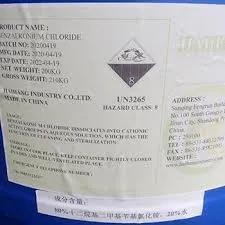organic phosphonate
The Significance of Organic Phosphonates in Modern Chemistry
Organic phosphonates are a fascinating class of compounds that have garnered significant attention in the fields of organic chemistry, materials science, and biochemistry. Characterized by the presence of a phosphorus atom bonded to carbon atoms, phosphonates are distinct from more traditional phosphorus-containing compounds such as phosphates. Their unique structure and properties have led to a wide array of applications, ranging from agriculture to pharmaceuticals and beyond.
Structure and Properties
The generic structure of an organic phosphonate can be represented as R1R2P(=O)(OR3), where R1, R2, and R3 are organic groups, and P represents the phosphorus atom. The P=O double bond and the P–C bonds impart unique chemical and physical properties to phosphonates, making them versatile building blocks in various synthetic pathways. The ability to modify the organic groups around the phosphorus atom allows chemists to fine-tune the properties of these compounds, leading to tailored functionalities for specific applications.
One of the key features of organic phosphonates is their resistance to hydrolysis, which makes them particularly valuable in agricultural and environmental contexts. Unlike phosphates, which can readily undergo hydrolysis and result in limited bioavailability in soils, phosphonates offer prolonged stability and efficacy when used as fertilizers or in herbicides. This stability is attributed to the P–C bond, which is less reactive than the P–O bond found in phosphates, thus ensuring that the beneficial effects of phosphonates can persist over time.
Applications in Agriculture
Organic phosphonates have become increasingly important in agriculture, particularly as a means of enhancing crop productivity and managing diseases. For instance, phosphonate-based fertilizers are used to improve phosphorus nutrition in plants, thereby promoting healthy growth and yielding better harvests. They are particularly advantageous in acidic or alkaline soils, where the availability of phosphorus can be limited.
Additionally, certain phosphonates, such as fosetyl-Al, are utilized as fungicides to combat a variety of plant pathogens. These compounds function by acting as systemic agents, allowing for the effective protection of plants from diseases such as downy mildew and oak wilt. By integrating organic phosphonates into agricultural practices, farmers can achieve higher crop yields while minimizing the environmental impact typically associated with traditional fertilizers and pesticides.
organic phosphonate

Role in Pharmaceuticals
Beyond their agricultural applications, organic phosphonates have also established a foothold in the pharmaceutical industry. Their ability to mimic the structure of biomolecules, such as nucleotides, has made them valuable in the development of antiviral and anticancer agents. For instance, compounds like tenofovir, an antiviral medication used to treat HIV, belong to the family of organic phosphonates. By incorporating phosphonate moieties into their structure, these drugs exhibit enhanced stability and bioactivity, making them effective therapeutic agents.
Moreover, organic phosphonates can serve as enzyme inhibitors by interacting with key biomolecules in metabolic pathways, leading to potential applications in drug design for various diseases, including cancer and neurodegenerative disorders. This capability stems from their structural similarity to phosphate groups, allowing them to competitively inhibit enzymes that rely on phosphorylation.
Environmental Concerns and Future Directions
Despite their benefits, the environmental impact of organic phosphonates must also be considered. Research has indicated that, while phosphonates are less soluble and more stable than phosphates, their accumulation in waterways can lead to unintended ecological consequences. As such, ongoing studies aim to understand their environmental fate, biodegradation pathways, and potential toxicity to non-target organisms.
Looking to the future, the exploration of organic phosphonates remains a vibrant area of research. Advances in synthetic methodologies, as well as a deeper understanding of their biological activity, promise to unlock new applications and innovations. Whether through the development of sustainable agricultural practices or the discovery of novel pharmaceuticals, organic phosphonates are poised to play a vital role in addressing some of the most pressing challenges we face today.
In conclusion, organic phosphonates represent a unique and valuable class of compounds with a wide range of applications across multiple fields. Their distinctive properties, coupled with a growing body of research, confirm their importance in modern chemistry and their potential to contribute positively to society. From enhancing agricultural productivity to paving the way for new medical therapies, organic phosphonates are indeed a significant component of contemporary scientific advancements.
-
Dodecyldimethylbenzylammonium Chloride: High-Purity DisinfectantNewsAug.30,2025
-
2-Phosphonobutane-1,2,4-Tricarboxylic Acid: Scale & CorrosionNewsAug.29,2025
-
Premium Isothiazolinones | Broad-Spectrum Biocidal SolutionsNewsAug.28,2025
-
LK-319 Special Scale And Corrosion Inhibitor For Steel Plants: Advanced Solutions for Industrial Water SystemsNewsAug.22,2025
-
Flocculant Water Treatment: Essential Chemical Solutions for Purification ProcessesNewsAug.22,2025
-
Isothiazolinones: Versatile Microbial Control Agents for Industrial and Consumer ApplicationsNewsAug.22,2025





